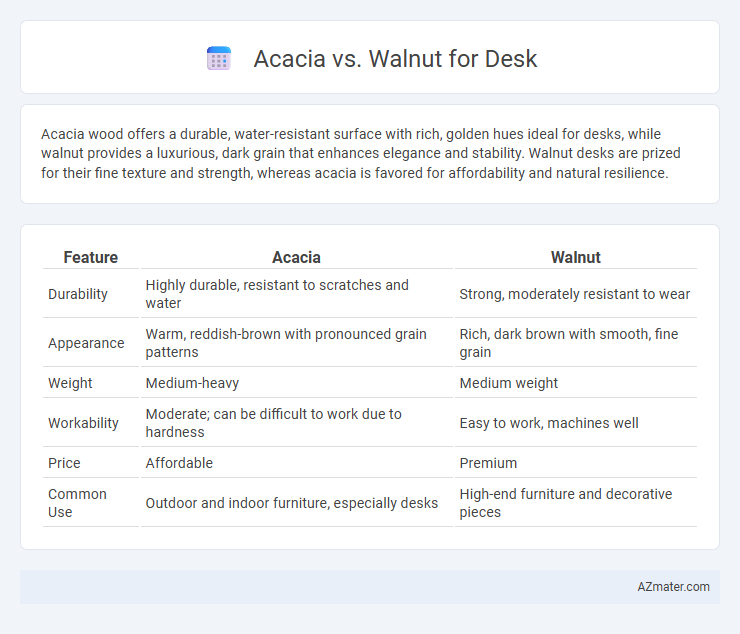Acacia wood offers a durable, water-resistant surface with rich, golden hues ideal for desks, while walnut provides a luxurious, dark grain that enhances elegance and stability. Walnut desks are prized for their fine texture and strength, whereas acacia is favored for affordability and natural resilience.
Table of Comparison
| Feature | Acacia | Walnut |
|---|---|---|
| Durability | Highly durable, resistant to scratches and water | Strong, moderately resistant to wear |
| Appearance | Warm, reddish-brown with pronounced grain patterns | Rich, dark brown with smooth, fine grain |
| Weight | Medium-heavy | Medium weight |
| Workability | Moderate; can be difficult to work due to hardness | Easy to work, machines well |
| Price | Affordable | Premium |
| Common Use | Outdoor and indoor furniture, especially desks | High-end furniture and decorative pieces |
Introduction: Acacia vs Walnut for Desk Choices
Acacia and walnut are two popular hardwood options for desks, each offering distinct durability and aesthetic qualities. Acacia wood is known for its rich, varied grain patterns and high resistance to wear, making it ideal for busy workspaces. Walnut features a smooth, dark finish with natural warmth and stability, favored for elegant, long-lasting furniture pieces.
Acacia Wood: Key Features and Benefits
Acacia wood boasts exceptional durability and resistance to moisture, making it an ideal choice for desks in both home and office settings. Its rich, warm tones and distinctive grain patterns provide a unique aesthetic appeal, enhancing the visual character of any workspace. The natural hardness and sustainability of acacia contribute to long-lasting furniture that combines strength with eco-friendly sourcing.
Walnut Wood: Key Features and Benefits
Walnut wood offers exceptional durability and a rich, dark grain pattern, making it ideal for high-quality desks that combine strength with aesthetic appeal. Its natural resistance to wear and warping ensures long-lasting furniture, while the smooth texture and fine finish provide a sophisticated workspace. Walnut's ability to age gracefully enhances its value, creating desks that develop deeper character and beauty over time.
Durability Comparison: Acacia vs Walnut
Acacia wood offers exceptional durability with high resistance to scratches and dents, making it a strong candidate for heavy-use desks. Walnut wood, known for its dense, tight grain and natural oils, provides excellent resistance to warping and cracking over time. Compared to walnut, acacia is generally harder and more resilient, while walnut delivers superior stability and a smoother texture under prolonged use.
Appearance and Grain Differences
Acacia wood features a rich, warm hue with a mix of golden and reddish-brown tones, displaying a varied and striking grain pattern that ranges from straight to wavy or interlocked. Walnut boasts a deeper, chocolate brown color with occasional purplish or gray undertones and exhibits a generally straight, fine, and smooth grain with subtle waves or curls. The contrast in grain complexity and color warmth between acacia and walnut gives each desk a distinctive aesthetic, with acacia offering a more rustic, varied look and walnut providing a sleek, elegant finish.
Workability and Maintenance
Acacia wood offers superior workability due to its fine grain and moderate hardness, making it easier to shape and finish for custom desks. Walnut, while slightly harder, provides excellent machinability and smooth sanding, resulting in a refined surface ideal for high-end furniture. In terms of maintenance, Acacia requires regular oiling to preserve its moisture resistance and prevent cracking, whereas Walnut benefits from occasional polishing to maintain its rich color and resist scratches.
Environmental Impact and Sustainability
Acacia wood for desks offers a faster growth cycle and higher renewal rate, making it a more sustainable option compared to walnut, which has a slower growth process and is often harvested from older, mature trees. Acacia trees are typically grown in plantations that support reforestation efforts, while walnut harvesting can contribute to habitat disruption in natural forests. Choosing acacia desks reduces carbon footprint due to its quicker regeneration and lower impact on biodiversity than walnut alternatives.
Cost Comparison: Acacia vs Walnut Desks
Acacia desks typically cost less than walnut desks due to the faster growth rate and greater availability of acacia wood. Walnut desks are priced higher, reflecting the wood's density, rich grain patterns, and limited supply, making them a premium choice for office furniture. Budget-conscious buyers often prefer acacia for cost-effective durability, while walnut appeals to those seeking luxury and long-term value.
Best Uses: Which Desk is Right for You?
Acacia desks offer durability and natural resistance to moisture, making them ideal for home offices and creative workspaces where aesthetic warmth and ruggedness are valued. Walnut desks provide a rich, elegant appearance with smooth grain patterns, perfect for executive offices or formal study areas where visual sophistication is prioritized. Choosing between Acacia and Walnut depends on your workspace environment, desired style, and maintenance preferences.
Final Verdict: Choosing Between Acacia and Walnut
Choosing between Acacia and Walnut for a desk depends on durability and aesthetic preferences, as Acacia offers high resistance to scratches and moisture, making it ideal for heavy use, while Walnut boasts rich, dark tones and a smooth grain, providing a luxurious finish. Walnut typically commands a higher price due to its premium appearance and status as a hardwood, whereas Acacia serves as a more budget-friendly, sustainable choice with impressive strength. Final verdict hinges on balancing budget constraints with desired style and long-term wear, positioning Walnut for elegance and Acacia for practical endurance.

Infographic: Acacia vs Walnut for Desk
 azmater.com
azmater.com